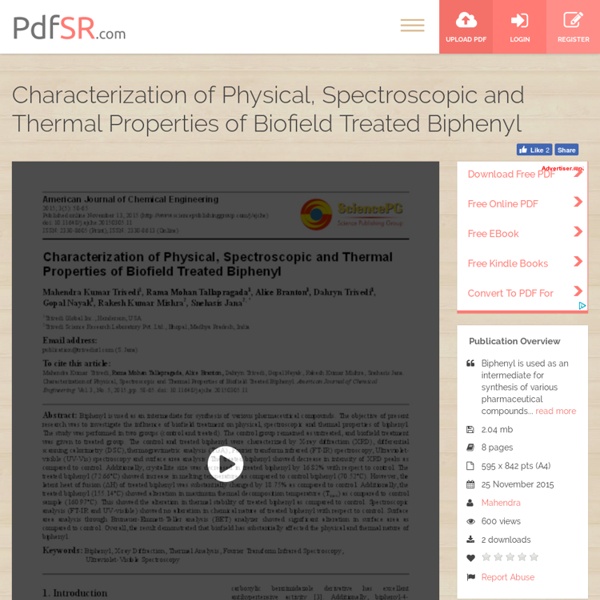



Brunauer-Emmett Teller Analysis: Biphenyl Abstract Biphenyl is used as an intermediate for synthesis of various pharmaceutical compounds. The objective of present research was to investigate the influence of biofield treatment on physical, spectroscopic and thermal properties of biphenyl. The study was performed in two groups (control and treated). Keywords: Biphenyl, X-ray Diffraction, Thermal Analysis, Fourier Transform Infrared Spectroscopy,Ultraviolet-Visible Spectroscopy 1. Biphenyl is an organic compound occurs naturally in coal tar, crude oil and natural gas and it is mainly isolated from these sources by distillation process. However, the biphenyl has low reactivity due to lack of functional groups [2] hence, it should be modified in order to improve its reaction kinetics. Researchers have experimentally demonstrated the presence of electromagnetic field around the human body using medical technologies such as electromyography, electrocardiography and electroencephalogram [11]. Mr. 2. 2.1. G = kλ/(bCosθ) (1) 2.2. 2.3. 3.
"Characterization of Physical, Spectroscopic and Thermal Properties of Description Biphenyl is used as an intermediate for synthesis of various pharmaceutical compounds. The objective of present research was to investigate the influence of biofield treatment on physical, spectroscopic and thermal properties of biphenyl. Citation Information Mahendra Kumar Trivedi. Mahendra Trivedi | Evaluation of Antibiogram, Genotype and Phylogenetic Analysis of Biofield Treated Nocardia otitidis | Dahryn Trivedi i o l g c a y s t e m p n Biological Systems: Open Access Trivedi et al,, Biol Syst Open Access 2015, 4: Open AccessResearch Article Volume 4 • Issue 2 • 1000143 Biol Syst Open Access ISSN: 2329-6577 BSO, an open access journal Evaluation of Antibiogram, Genotype and Phylogenetic Analysis of Biofield Treated Nocardia otitidis Mahendra Kumar Trivedi , Alice Branton , Dahryn Trivedi , Gopal Nayak , Sambhu Charan Mondal and Snehasis Jana Trivedi Global Inc., 10624 S Eastern Avenue Suite A-969, Henderson, NV 89052, USA Trivedi Science Research Laboratory Pvt. Abstract Nocardiosis is a soil-borne aerobic infection caused by Nocardia species commonly affects the respiratory tract. Nocardia otitidis (N. otitidis) is the key organism for non-mycobacterial tuberculosis. investigate the effect of Mr. N. otitidis and analyzed for antimicrobial susceptibility pattern, minimum inhibitory concentration (MIC), DNA polymorphism by Random Amplied Polymorphic DNA (RAPD) Enterobacter aerogenes .
Publication meta - Characterization of Physical, Spectroscopic and Thermal Properties of Biofield Treated Biphenyl - Publications Biphenyl is used as an intermediate for synthesis of various pharmaceutical compounds. The objective of present research was to investigate the influence of biofield treatment on physical, spectroscopic and thermal properties of biphenyl. The study was performed in two groups (control and treated). The control group remained as untreated, and biofield treatment was given to treated group. The control and treated biphenyl were characterized by X-ray diffraction (XRD), differential scanning calorimetry (DSC), thermogravimetric analysis (TGA), Fourier transform infrared (FT-IR) spectroscopy, Ultraviolet-visible (UV-Vis) spectroscopy and surface area analysis.
Biphenyl- DSC Study Description Biphenyl is used as an intermediate for synthesis of various pharmaceutical compounds. The objective of present research was to investigate the influence of biofield treatment on physical, spectroscopic and thermal properties of biphenyl. Keywords Biphenyl, Biphenyl As Reaction Intermediate, Biphenyl Intermediate For Organic Synthesis, Biphenyl Physical Properties, Biphenyl TGA Analysis, Biphenyl Surface Area Analysis, Thermal Stability Of Biphenyl, Thermal Properties Of Biphenyl, Crystallite Size Of Biphenyl, Biphenyl Ir Spectrum, Biofield, Mahendra Kumar Trivedi, The Trivedi Effect, Biofield Energy, Biofield Treatment, Biofield Energy Treatment Publication Date November 13, 2015 10.11648/j.ajche.20150305.11 Citation Information Mahendra Kumar Trivedi, Rama Mohan Tallapragada, Alice Branton, Dahryn Trivedi, Gopal Nayak, Rakesh Kumar Mishra, Snehasis Jana.
Mahendra Trivedi Mahendra Trivedi | The Potential Impact of Biofield Treatment on Human Brain Tumor Cells: A Time-Lapse Video Microscopy Study background: Glioblastoma (GBM) is the most common subtype of primary brain tumor in adults. The aim was to evaluate the impact of biofield treatment potential on human GBM and non-GBM brain cells using two time-lapse video microscopy technique. Methods: The human brain tumor, GBM cultured cells were divided into two groups viz. GBM control and GBM treatment. Similarly, human normal brain cultured cells (non-GBM) were taken and divided into two groups viz. non- GBM control and non-GBM treatment. The GBM and non-GBM treatment groups were given Mr. Results: GBM control cells showed a basal level of cell death 10 hours prior and 10 hours after the biofield treatment, and the rate remained unchanged over the 20 hours period, while in treatment group of GBM, cell death rate was exponentially increased (41%) after biofield treatment as compared to control.
Characterization of Physical, Spectroscopic and Thermal Properties of Biofield Treated Biphenyl Biphenyl is used as an intermediate for synthesis of various pharmaceutical compounds. The objective of present research was to investigate the influence of biofield treatment on physical, spectroscopic and thermal properties of biphenyl. The study was performed in two groups (control and treated). The control group remained as untreated, and biofield treatment was given to treated group. The control and treated biphenyl were characterized by X-ray diffraction (XRD), differential scanning calorimetry (DSC), thermogravimetric analysis (TGA), Fourier transform infrared (FT-IR) spectroscopy, Ultraviolet-visible (UV-Vis) spectroscopy and surface area analysis. The treated biphenyl showed decrease in intensity of XRD peaks as compared to control.
Human Energy Treatment | Biphenyl 0WordPress0CiteULike0 17 Biphenyl is used as an intermediate for synthesis of various pharmaceutical compounds. The objective of presentresearch was to investigate the influence of biofield treatment on physical, spectroscopic and thermal properties of biphenyl.The study was performed in two groups (control and treated). The control group remained as untreated, and biofield treatmentwas given to treated group. The control and treated biphenyl were characterized by X-ray diffraction (XRD), differentialscanning calorimetry (DSC), thermogravimetric analysis (TGA), Fourier transform infrared (FT-IR) spectroscopy, Ultravioletvisible(UV-Vis) spectroscopy and surface area analysis. Your session has expired but don’t worry, your message has been saved.Please log in and we’ll bring you back to this page. Your evaluation is of great value to our authors and readers. Review When you're done, click "publish" Only blue fields are mandatory. No one besides you has access to this list. Description